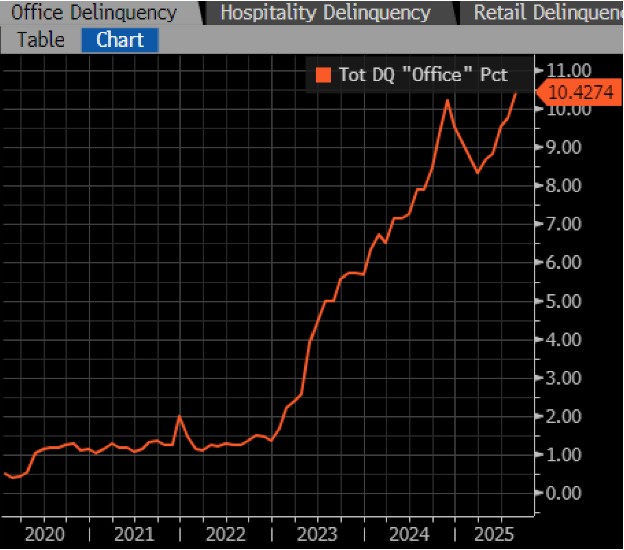Commercial Mortgage Delinquencies Now Surpass 2008 Financial Crisis Peak

In November 2024, US commercial mortgage delinquencies spiked to 10.4 percent, a level just below the 10.7 percent peak during the 2008 financial crisis. Commercial real estate (CRE) delinquencies surged again in August 2025, with office and multifamily loans at the center of the slide despite widespread use of “extend-and-pretend” and forbearance tactics designed to stave off losses.
According to Trepp, the delinquency rate of office mortgages packaged into commercial mortgage-backed securities (CMBS) jumped to 11.7 percent, surpassing the Financial Crisis peak of 10.7 percent. As recently as December 2022, the rate stood at only 1.6 percent, highlighting how quickly stress has spread. Multifamily CMBS delinquency rates also spiked, reaching 6.9 percent, their highest since 2015. Two years ago, the figure was just 1.8 percent.
The sharp deterioration reflects rising vacancies, elevated borrowing costs, and weak demand. Newer, higher-quality office buildings continue to lure tenants away from older towers, leaving the latter with mounting vacancies and unsustainable debt. Multifamily, once considered among the safest CRE classes, has been dragged down by a mix of aggressive construction, financing costs, and slowing rent growth.
Multifamily has now become the second-weakest CRE category after office, ahead of lodging CMBS at 6.5 percent and retail CMBS at 6.4 percent. Industrial property loans remain comparatively healthy at 0.6 percent.
Both office and multifamily buildings stand out for the scale of their deterioration. In office space, the biggest problems involve older towers struggling to compete. Multifamily spaces, though broadly supported by housing demand, face their own pressures from overbuilding in certain markets and refinancing challenges.
Much of the “improvement” in delinquency rates comes from accounting maneuvers rather than true recoveries. Loans are deemed “cured” not only when interest resumes or properties are sold, but also when lenders agree to extend maturities, restructure payments, or provide forbearance. These strategies push problems into the future but rarely resolve the underlying issues.
One example is the $1.04 billion mortgage on 1211 Avenue of the Americas, a 2-million-square-foot Midtown Manhattan tower. The 1973 property became delinquent in August when its balloon payment was missed. Yet a three-year extension, pushing maturity to 2028, means the loan will soon come off Trepp’s delinquency list.
Similarly, the $335 million Times Square Plaza loan was “cured” in August through a forbearance agreement lasting until 2026, with options for two additional extensions. As part of the deal, the borrower must inject $14 million in equity and guarantee $20 million for leasing and capital expenditures.
But not all loans receive reprieves. In multifamily, the $62 million mortgage on Manhattan’s Park West Village, covering 850 units, became newly delinquent in August after missing payments.
Unlike the 2008 crisis, US banks are not the primary holders of office loan risk. Most exposure is distributed across institutional investors via CMBS, collateralized loan obligations (CLOs), REITs, and private credit vehicles. Some banks, particularly foreign ones such as Deutsche Bank, did accumulate heavy office exposure and have already taken write-downs or sold loans at steep discounts. But overall, the US banking system’s direct exposure is limited.
Multifamily loans, however, represent a much larger share of CRE debt — about $2.2 trillion, or 45 percent of the $4.8 trillion total. Roughly half of this debt is backed by government-sponsored entities (Fannie Mae and Freddie Mac), whose share of multifamily exposure has doubled in the past decade. Banks and thrifts hold 29 percent, life insurers 12 percent, and private CMBS and related securities just three percent.
This distribution means investors and government-backed agencies will bear the bulk of losses. For banks, while individual institutions may face strain, the system as a whole is unlikely to see CRE losses metastasize into a systemic crisis.
The record delinquency rates in office loans — and worsening conditions in multifamily — underscore the depth of stress in CRE. While “cures” through extensions and forbearances will reduce headline delinquency rates, they primarily defer the reckoning. The longer vacancies remain elevated and refinancing remains costly, the greater the risk of losses eventually crystallizing.
For now, the fallout is being absorbed by institutional investors and government agencies rather than threatening the banking system. But the scale of distress in two of the largest CRE categories signals that the sector is undergoing a slow, grinding reset with few straightforward solutions in sight.
The post Commercial Mortgage Delinquencies Now Surpass 2008 Financial Crisis Peak was first published by the American Institute for Economic Research (AIER), and is republished here with permission. Please support their efforts.

